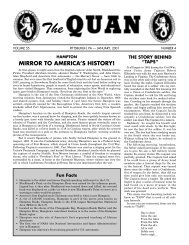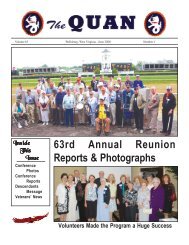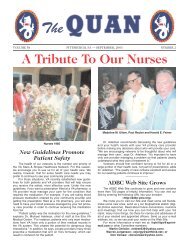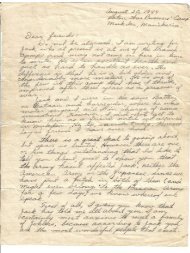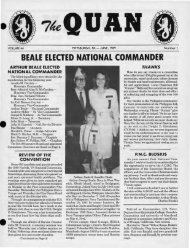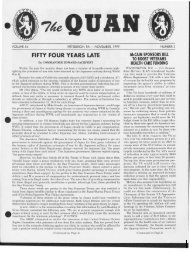June/July 2002 - Philippine Defenders Main
June/July 2002 - Philippine Defenders Main
June/July 2002 - Philippine Defenders Main
You also want an ePaper? Increase the reach of your titles
YUMPU automatically turns print PDFs into web optimized ePapers that Google loves.
Death March Horrors<br />
to the Fore<br />
Bataan Survivors Sue, Push for<br />
Recognition of Wartime Suffering<br />
By STEVE VOGEL<br />
Washington Post Staff Writer<br />
Mel Rosen’s introduction to being a prisoner<br />
of war came in the first hours after<br />
he and his troops surrendered to the Japanese<br />
in the <strong>Philippine</strong>s in spring 1942.<br />
As they sat in a big field ringed by<br />
Japanese machine guns on the Bataan<br />
peninsula, a GI tried to use the latrine. A<br />
Japanese soldier thrust his bayonet<br />
through the American’s chest, and when<br />
the blade did not come out cleanly, the<br />
Japanese soldier used his foot to push the<br />
dying GI into the latrine.<br />
“Another Japanese soldier nearby was<br />
leaning on his rifle laughing, like it was a<br />
joke,” said Rosen, a vibrant 83-year-old<br />
retired Army colonel living in Falls<br />
Church, who 60 years later cannot tell the<br />
story without choking up. “You don’t know<br />
what frustration is till you have to watch<br />
something like that and can’t do anything<br />
about it.”<br />
With the 60th anniversary of the<br />
Bataan Death March being observed this<br />
spring, new attention is being paid to one<br />
of the most horrific episodes of World War<br />
II.<br />
Today, Rosen will be among the dwindling<br />
number of Bataan survivors who<br />
will be honored as part of the National<br />
Memorial Day Concert. The event will be<br />
broadcast live across the country from the<br />
West Lawn of the U.S. Capitol, starting at<br />
8 p.m.<br />
Meanwhile, there is a growing movement<br />
among Bataan veterans to force<br />
Japan to apologize and compensate them,<br />
with lawsuits being pursued in U.S. and<br />
Japanese courts.<br />
Legislation that would allow survivors<br />
to sue Japanese corporations that allegedly<br />
enslaved American POWs during World<br />
War II was introduced last year in the<br />
House and Senate. A House resolution<br />
with more than 225 co-sponsors will be<br />
pushed in coming weeks.<br />
While the Bataan Death March has<br />
entered the U.S. lexicon — often in references<br />
that trivialize its inhumanity — the<br />
full extent of the horrors that ensued for<br />
survivors is little understood. “I think it’s<br />
time people learned what happened over<br />
there,” said Paul Reuter, 81, an Oxon Hill<br />
man who survived the march and more<br />
than three years of captivity. “That part of<br />
history has been lost.”<br />
Marching for days in terrible heat, beaten<br />
and deprived of food and water, an estimated<br />
7,000 to 10,000 of the 78,000<br />
Americans and Filipinos who surrendered<br />
to the Japanese died during the march.<br />
Over the next three years, those who<br />
survived were kept in horribly debilitating<br />
conditions and exposed to tropical diseases,<br />
transported in “hell ships” to camps<br />
14 — THE QUAN<br />
in Japan and elsewhere, and forced into<br />
slave labor.<br />
Of the 12,000 Americans taken prisoner<br />
at Bataan, only 4,000 were alive by the<br />
end of the war, according to authorities on<br />
the subject.<br />
Rosen is the lead plaintiff in a $1 trillion<br />
class-action lawsuit against Japan<br />
filed in September in federal court in<br />
Chicago. “Everything the Japanese did to<br />
us was deliberate, inhuman, brutal, calculated<br />
and racist,” he said.<br />
Rounded Up<br />
Hours after the raid on Pearl Harbor on<br />
Dec. 7, 1941, U.S. forces in the <strong>Philippine</strong>s<br />
also were attacked by Japanese bombers<br />
and fighters, and later that month, by a<br />
large invasion force of the Imperial<br />
Japanese Army.<br />
The U.S. troops and their Filipino allies<br />
fighting on the Bataan peninsula across<br />
the bay from Manila held out against<br />
heavy odds for 150 days, until their<br />
ammunition, medical supplies and food<br />
gave out. After their surrender April 9,<br />
the prisoners were rounded up and<br />
marched north for days, up to 55 miles in<br />
the heat without water.<br />
“If anybody dropped or couldn’t make it,<br />
we were not allowed to help. The Japanese<br />
clubbed them to death, bayoneted them,<br />
shot them or beheaded them,” said Rosen,<br />
a 1940 West Point graduate who was a<br />
lieutenant with the <strong>Philippine</strong> Scouts.<br />
“There were hundreds of American bodies<br />
and thousands of Filipino bodies left along<br />
the route of the death march.”<br />
At a railhead, they were loaded into hot,<br />
crowded box cars. “If you died in there,<br />
you couldn’t fall to the floor even,” said<br />
Reuter, a B-17 radio operator who was<br />
based at Clark Field in the <strong>Philippine</strong>s.<br />
At their eventual destination, Camp<br />
O’Donnell, 54,000 prisoners were<br />
crammed into facilities built for a fraction<br />
as many people. Malaria and dysentery<br />
killed thousands more.<br />
In November 1942, Rosen was sent to a<br />
penal colony on the island of Mindanao,<br />
and he spent the next two years working<br />
in rice fields. “I planted rice, weeded rice,<br />
harvested rice, milled rice. Got damn little<br />
of it to eat,” he said.<br />
Aboard ‘Hell Ships’<br />
Two years later, he and 1,600 other<br />
Americans were loaded onto a ship bound<br />
for Japan, where they were to be used as<br />
slave labor in factories. Rosen was put in a<br />
30-by-50-foot hold with about 680 prisoners.<br />
Many had diarrhea and dysentery, and<br />
the hold was soon ankle-deep in human<br />
waste. The next morning, the ship was<br />
attacked by U.S. dive bombers, whose<br />
pilots did not know that Americans were<br />
aboard.<br />
Another attack by U.S. planes came the<br />
next day, and as the ship began to sink,<br />
prisoners emerged from the hold. “Those<br />
of us still alive decided getting our heads<br />
blown off by machine gun fire was prefer-<br />
able to going down in a sinking, burning<br />
ship,” Rosen said.<br />
The 1,300 American survivors who<br />
swam ashore were loaded onto a second<br />
ship. They reached a harbor in Formosa,<br />
now Taiwan, in January 1945 when U.S.<br />
bombers struck again. “The Japanese kept<br />
us down there with our dead and dying for<br />
four days, and on the fifth day, lowered a<br />
net and said, ‘Pile all your dead in here,’ ”<br />
Rosen said.<br />
Aboard a third ship, prisoners froze as<br />
they sailed in the North China Sea with<br />
little protection from the January cold.<br />
“We were throwing American bodies overboard<br />
at the rate of 30, then 40, then 50 a<br />
day all the way to Japan,” Rosen said.<br />
By various estimates, 200 to 300 of the<br />
1,600 prisoners loaded on the first ship<br />
made it to Japan. “The death march was a<br />
Sunday stroll compared to the three hell<br />
ships,” Rosen said.<br />
When Rosen arrived in Japan and was<br />
put on a scale, his weight had dropped<br />
from a normal 155 pounds to 88 pounds.<br />
Reuter, who had been shipped to Japan<br />
earlier, spent two years working in a steel<br />
mill south of Osaka. Others were sent to<br />
coal mines. “We were money machines for<br />
them,” Reuter said.<br />
One day in August 1945, Reuter and his<br />
fellow prisoners found that their Japanese<br />
guards were gone. The Americans asked<br />
some Korean prisoners what had happened.<br />
“They said the war was over.<br />
Something had happened at Hiroshima.”<br />
Rosen was at a camp in Korea when liberation<br />
came.<br />
“A lot of people say you must really hate<br />
the Japanese,” Rosen said. He does not, he<br />
is quick to say. The home he shares with<br />
his wife, live, includes Japanese artifacts<br />
picked up on travels during a 30-year<br />
Army career.<br />
The lawsuit he has filed is being pursued<br />
for symbolic, not monetary, reasons,<br />
Rosen said. “The Japanese are waiting for<br />
us to die off,” he said.<br />
When a U.S. Navy submarine accidentally<br />
sank a Japanese trawler off Hawaii<br />
last year, the U.S. promptly apologized, a<br />
proper gesture, Rosen said.<br />
“I have been waiting 60 years for an<br />
apology from Japan.”<br />
————————<br />
VA Benefits are Tax Exempt<br />
VA benefits — compensation, pension,<br />
DIC, education, work study, even dividends<br />
and proceeds from life insurance<br />
policies, are exempt from federal income<br />
tax. (Proceeds from insurance are subject<br />
to federal estate taxes.) Also exempt from<br />
income tax is interest accrued on dividends<br />
left on deposit or credit account<br />
with VA.<br />
————————




